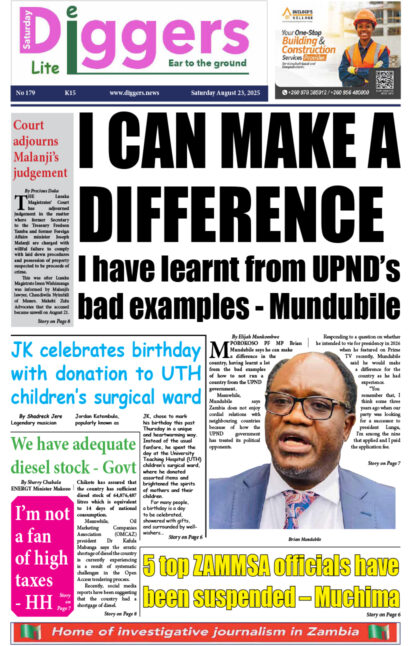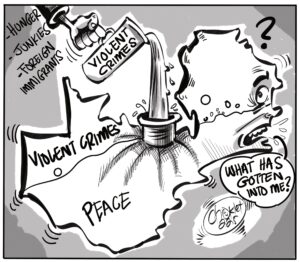In recent weeks, Zambia has witnessed a surprising yet welcome development: the Zambian kwacha has appreciated noticeable against the U.S. dollar. Trading around K26.88 per dollar in Mid-May, the local currency strengthened to nearly K24.25 per dollar by mid-June— representing a gain of over 9.8% within just a few weeks. For a currency that has faced prolonged depreciation, this rebound attracts some important questions: What is driving the appreciation? What does it mean for the economy? And, perhaps most critically, is it sustainable?
For ordinary citizens, the appreciation of the kwacha can feel like a quiet sigh of relief. A stronger kwacha means cheaper imports—fuel, medicine, machinery, and food items become relatively less expensive. For Zambia an import-reliant economy, this can help cushion inflationary pressures, reduce cost of doing business and ease pressure on households battling high transport costs and food prices.
In this weeks Monday Opinion, I explore this topic around the Kwacha’s appreciation and sustainability.
Kwacha gains are temporary – Driven by short-term money flows, not lasting Economic Change
Beneath the surface, the drivers of this appreciation reveal a more complicated reality—one shaped more by short-term liquidity dynamics and policy actions than by deep-rooted economic transformation.
Firstly, the gain is attributed to mid-year tax obligations, especially Pay-As-You-Earn, corporate taxes, and other statutory dues, a trend that has been consistent over the past years – have encouraged exporters and companies to convert their U.S. dollar earnings into kwacha to meet domestic liabilities. This seasonal factor creates temporary surges in the dollar supply on the market, leading to short bursts of currency strength.
The second driver is a noticeable decline in demand for foreign exchange arising largely from the reduced fuel imports costs. With international fuel prices softening during this period, pump price for petrol declined by 2.5% from US$73.47/bbl. to US$71.63/bbl., Diesel reduced by 4.06 percent from US$79.79/bbl. to 76.55/bbl. and Jet A1 fell from US$79/bbl. to US$75.58/bbl. representing 4.33 percentage reduction and corporate demand for dollars moderating, the pressure on the kwacha has eased. Lower demand for the U.S. dollar, in a market where supply is relatively fixed, naturally boosts the local currency.
Another factor supporting the currency is the recent progress made on the debt restructuring front. Agreements with key creditors like the India EXIM Bank to restructure US$335 million, alongside ongoing support from International Monetary Fund (IMF), Zambia recently reached a staff level agreement which once approved would unlock access to 139.9 million Special Drawing Rights (SDR) equivalent to US$194 million in financing, improving investor sentiment. Confidence matters in currency markets. Positive sentiment can attract short-term portfolio flows, leading to additional foreign exchange inflows and a stronger currency.
Can this trajectory be sustained over the medium term?
While the current appreciation trend offers some breathing space, the bigger question is whether this trajectory can be sustained over the medium term.
In the short term, the kwacha may hold firm or even appreciate further, buoyed by continued tax-related conversions, subdued import demand, and possible additional foreign exchange interventions. However, as tax season fades and corporate obligations are met, the inflow of dollars may taper off. Meanwhile, the economy’s structural demand for imports, especially fuel, medicines, and electricity-related inputs, remains elevated. This will likely renew demand for greenback, putting pressure back on the kwacha.
In the medium term, sustaining appreciation will require more than just tactical policy responses. Zambia will need to address the structural imbalances that drive persistent currency weakness by boosting local production in agriculture and Manufacturing to reduce dependency on imports, promoting investment in the energy sector, investing in domestic processing of raw materials and enhancing competitiveness of non-traditional exports.
At the same time, prudent fiscal management remains vital. The government must demonstrate continued discipline in managing the budget, meeting debt restructuring obligations, and following through on commitments made under the G20 Common Framework and the IMF Extended-Credit-Facility. Failure to maintain credibility with investors and development partners could reverse current gains swiftly.
Conclusion
The appreciation of the kwacha is not just a financial statistic; it is a window into the complex intersection of market dynamics, policy choices, and economic structure. For now, it provides a measure of relief in an economy grappling with high costs and constrained growth. But let us not be lulled into complacency. This rebound, while encouraging, is fragile. Without deliberate steps to address the underlying causes of currency volatility, the gains we see today could evaporate tomorrow.
About the Author
Robert Mwale serves as Lead Public Finance Researcher at the Centre for Trade Policy and Development (CTPD). He also serves as Coordinator for the Zambia Civil Society Organization Debt Alliance (CSO DA) as well as Coordinator for the Zambia Tax Platform (ZTP). He holds a bachelor’s degree in economics from the University of Zambia (UNZA), A Master of Science in economics from the Copperbelt University as well as a Master of Science in Financial Services from ZCAS University. He also has qualifications and competency in Investment Advisor and Stockbrokers Course.

























One Response
Gold mining in north western province should erase all these debt we have . The pound is strong because of the gold reserves that they dubiously have. The problem with Africa is that we put politics first. Democracy has disadvantaged us. You will bring all the economics but as long as the west is controlling you will continue wasting your time Mr economist